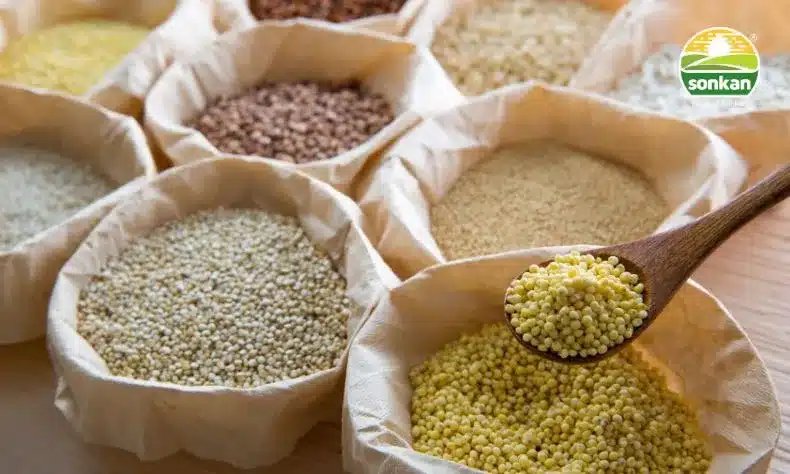From aiding digestion to strengthening bones, discover the unique health benefits each millet brings to your plate. Read on to explore the simplicity and richness of these grains for a healthier lifestyle.
Introduction:
Millet, often hailed as the “small grains with big benefits,” has entrenched itself as a dietary staple in Indian households for centuries. The resurgence of interest in millets in recent years can be attributed to their exceptional nutritional richness and adaptability. As various millet varieties vie for attention, a crucial question surfaces: which is the healthiest millet in India? In this comprehensive exploration, we will meticulously dissect the nutritional profiles of some of the most popular millets, shedding light on their unique health benefits.
- Foxtail Millet:
Commonly known as “Kangni” in Hindi, foxtail millet has stood the test of time as one of the oldest cultivated millets in India. This gluten-free grain boasts a remarkable nutritional profile. Rich in dietary fiber, foxtail millet promotes digestive health by supporting regular bowel movements and preventing constipation. Additionally, it is a potent source of essential minerals such as iron, magnesium, and phosphorus, which are pivotal for various bodily functions. The slow-digesting nature of foxtail millet makes it an excellent choice for individuals looking to manage blood sugar levels effectively, rendering it particularly suitable for those with diabetes.
- Pearl Millet:
Widely known as “Bajra,” pearl millet has earned its place as a drought-resistant crop in India. What sets pearl millet apart is its high protein content, making it a valuable addition to vegetarian diets. Beyond protein, pearl millet is rich in iron, magnesium, and phosphorus, contributing significantly to bone health and preventing conditions like anemia. The fiber content in pearl millet not only aids digestion but also assists in weight management, making it a multifaceted grain for overall well-being.
- Finger Millet:
The popular “Ragi,” or finger millet, has witnessed a surge in popularity due to its exceptional nutritional profile. This millet variety is a powerhouse of calcium, a crucial component for maintaining strong and healthy bones. Beyond calcium, ragi is rich in antioxidants and boasts a low glycemic index, making it an ideal choice for individuals managing diabetes. The high amino acid content in finger millet enhances protein absorption, adding to its allure as a nutritious grain for a diverse range of dietary needs.
- Sorghum Millet:
Known as “Jowar” in India, sorghum millet stands out for its gluten-free nature and versatility as a staple. Jowar is an excellent source of energy, providing complex carbohydrates that release energy slowly, promoting sustained vitality. Packed with essential vitamins and minerals, including B vitamins and iron, sorghum millet contributes to overall health and well-being. Its rich antioxidant content aids in combating oxidative stress, showcasing its potential in promoting longevity.
- Little Millet:
Referred to as “Kutki” or “Samai,” little millet has carved a niche for itself as a nutrient-dense option. This millet variety is a good source of B vitamins, particularly niacin and thiamine, which play pivotal roles in metabolism and energy production. Little millet is not only gluten-free but also offers a healthy alternative for those with gluten sensitivities. The high fiber content supports digestive health and assists in weight management, making it a versatile addition to a balanced diet.
- Barnyard Millet:
Known as “Sanwa,” barnyard millet stands out with its nutty flavor and unique nutritional composition. It is a rich source of essential micronutrients such as iron and zinc, crucial for maintaining immune function and preventing deficiencies. Being gluten-free and boasting a low glycemic index, barnyard millet is a suitable choice for individuals managing diabetes. The dietary fiber content in this millet aids in promoting a healthy digestive system, contributing to overall gastrointestinal well-being.
Conclusion:
In the quest to determine the healthiest millet in India, it becomes evident that each variety offers a unique set of nutritional benefits. Foxtail millet excels in supporting digestive health and managing blood sugar levels. Pearl millet, with its high protein content, is invaluable for vegetarians and contributes significantly to bone health. Finger millet stands out with its exceptional calcium content and low glycemic index, making it an ideal choice for bone health and diabetes management. Sorghum millet emerges as an excellent source of sustained energy and antioxidants, contributing to overall well-being. Little millet, with its rich B vitamin content, aids in metabolism and energy production, while barnyard millet offers a nutty flavor along with essential micronutrients for immune function.
The determination of the healthiest millet in India remains an open exploration, contingent upon individual dietary requirements and health goals. By incorporating a variety of millets into one’s diet, individuals can harness the collective benefits of these grains, enjoying a diverse array of nutrients that contribute to overall health and well-being. Thus, the quest for the healthiest millet persists as an ongoing exploration, with the answer lying in the synergy of a balanced diet that includes different millet varieties.

